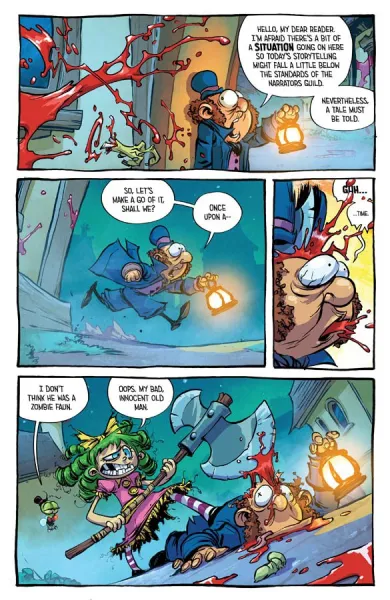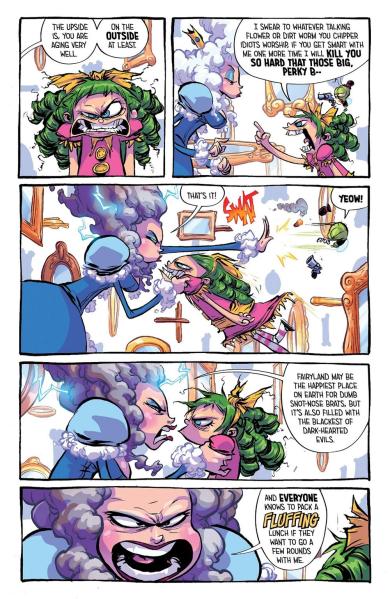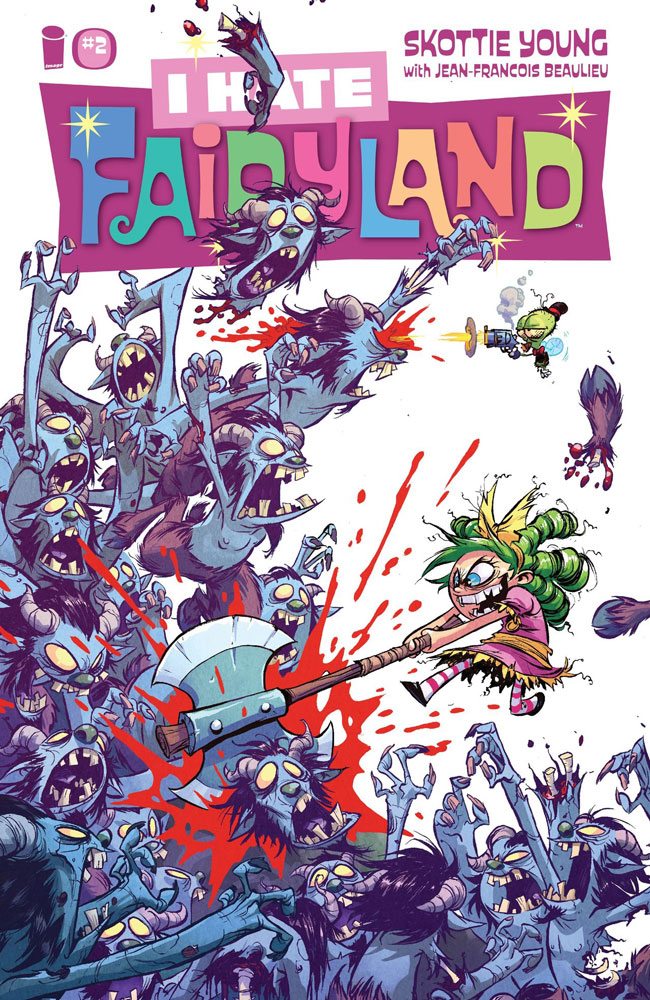What images does the term “fairyland” conjure in your imagination? In mine, it can go one of two ways: magic supreme wielded by gorgeous, untouchable creatures or a silly, bubbly place populated by chubby unicorns who fart rainbows.
Illusions are lovely, aren’t they?
The “reality” presented to us by Skottie Young in I Hate Fairyland is neither of those things.
For those of you who have yet to partake, the basic premise is as follows: Gertrude, a lovely, young girl has spent her short life thus far longing to go to Fairyland. One day, she is given her wish, is swallowed by her vomitously pink carpet and falls down a long, dark tunnel, much like Alice falling into Wonderland. Except when Gertrude hits bottom, she ends up missing several teeth and suffering from a compound fracture of her arm.
After which Queen Cloudia, all bubbles and delight, sends her on a quest for a key that will allow her to go home.
Cue time lapse.
Thirty years later, Gertrude is still questing. Her mind has evolved, but she’s still trapped in a six-year-old body. She is a hard-drinking, sarcastic, murderous woman with pretty green curls and a magnificent bow, accompanied by her equally sarcastic, top-hat wearing housefly. And she has had more than enough of Fairyland.
She expresses her ire by such activities as: blowing up the moon, her story’s first narrator, when he makes one too many snarky comments…

Going on killing sprees…

And trying desperately to come to terms with the death of her dreams…

All of this while trying to find that damn key and with Queen Cloudia attempting to thwart Gertrude constantly, just because she can and because Gertrude has exposed the less than lovely underbelly of Cloudia’s kingdom.

Fair enough, Cloudia. Fair enough.
The point of Young’s glorious mayhem?
I’ll give you a clue: Young is trying to remind us of a vital aspect of the human experience and that which we should be doing to make existence more tolerable, something we often forget, or willfully set aside, in the heat of a moment or the chaos of a busy day. Something that takes a lot of effort and is often uncomfortable or discomfiting. Something we’d rather not do because it often forces us to confront what is ugly and cruel and sad in human nature:
Not everything is as it seems.
Very little, in fact, is.
There is, so often, more to the story.
And it is our responsibility as decent human beings to go looking for the missing pieces, the rest of the picture. The origin stories, if you will, of the people with whom we exist.
Gert has an image of Fairyland in her six-year-old imagination, which seems akin to my rainbow-farting unicorn version. Puffy clouds and pixie dust, cotton candy and walking stuffed animals. The Fairyland she is given is one wherein the laws of physics and biology still apply. One peopled by living, breathing beings who have their own personalities and thus, cannot be forced to conform to her expectations. They all came from somewhere. They are all going somewhere. And they are, each of them, far more than their exterior, including Gert.
Young’s artistic style is used to great advantage to lend weight to the “moral.” He is well known for his work on books like Little X-Men vs. Little Avengers and Rocket Raccoon, which were targeted, primarily, at the younger set. As you can tell from the panels above, I Hate Fairyland would give most kids nightmares (it gives me the giggles, but then, it is a fact widely acknowledged that I have a sick sense of humor). Using that same style in a book like I Hate Fairyland gives credence to the fundamental foundation of the story: So often in life, we base our expectations on what is immediately in front of us (an adorable child) instead of taking the time and effort to look deeper (a woman, trapped in a child’s body, who has been struggling constantly for thirty years to get home).
Not everything is as it seems.
That bully you dealt with in middle school? The one you tried to befriend, who pushed everyone away despite good intentions and best efforts? She was being abused by her father. He hit her and told her constantly how worthless she was. She starved herself so that she could be the perfect ballerina and maybe he would finally be proud of her, or at least leave her alone, but it didn’t work. She was living in a prison and anyone sharing the cell was another potential abuser, someone who could hurt her. She was terrified, so she isolated. Does that make her bullying behavior acceptable? No, absolutely not. But you understand now, don’t you?
That helicopter mom at the park? She wants her child to play and have friends but she has crippling anxiety and she’s afraid if she turns away, moves a few feet to sit on the bench next to you, gives you her attention for half a second, her child will get hurt, be paralyzed or worse. She doesn’t want to live in fear. She hates it. But she’s ashamed of what she views as a lack of control, of falling short of perfection, and she doesn’t want you to see it. That’s why she isn’t joining in the conversation. That’s why she says no to play dates and mom’s groups. It may seem as though she thinks she’s better than you, but in reality, she’s terrified that you’ll see through her facade and judge her.
That child having a tantrum in the middle of a restaurant and the parents who allow it? That child is autistic and they’re doing what they feel is best for him or what they have to do. Because maybe mom, who had to quit a job she loves in order to give her child the best possible care, to take him to early intervention appointments and therapy appointments, hasn’t eaten all day and she’s on the verge of tears, and dad, who is trying to support everyone financially and emotionally, is at the end of an overtime shift and he hasn’t eaten all day either.
Jean Valjan didn’t steal bread because he was a thief. He stole bread because he was trying to save his family.
Ezra Bridger didn’t trust Darth Maul because he wanted to go Sith. He did it to save his friends and the galaxy from Vader.
There is always more to the story.
Am I excusing all behaviors as a product of backstory? No, absolutely not. I don’t care what happened to you, you don’t abuse children, you don’t abuse the elderly or your partner. You don’t walk up to someone and shoot them in the head. Racism and bigotry can be products of upbringing but it’s an individual’s responsibility to remedy those things once they’re out from under the influence of their past. There is a whole litany of things that are not okay.
I’m just suggesting that, before you judge, you take the time to find out what’s below the surface. If it’s still inexcusable, it’s still inexcusable, but at least you know. You took the time, you made the effort. You were the best possible human you could be and you gave someone a chance, someone who may never have been given a chance before. Maybe that one chance is all the person needed.
She who saves a life, saves a world.
Maybe by giving that person that chance at that moment, you saved a world.
You don’t have to like someone to understand her. You don’t need to like someone to be sympathetic if not empathetic.
And if there isn’t anything else? Or the else is simply too despicable? At least you tried.
Be excellent to each other until you know that.
You may get burned. You may end up with some scars. But the world will be a better place for your effort.
And for you.





